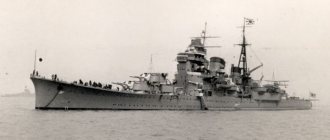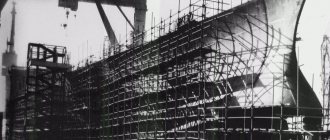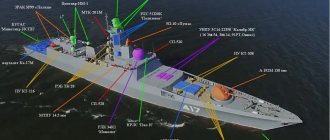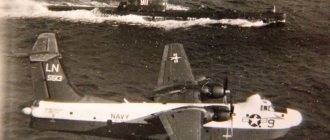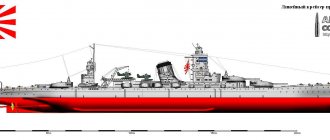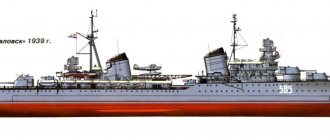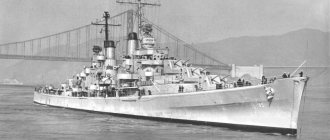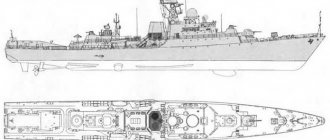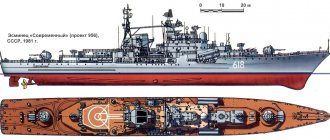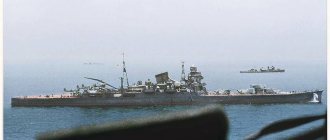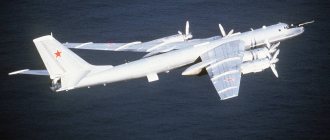Ships of Armageddon. Heavy aircraft-carrying cruisers of Project 1143
Reading the article “The Most Absurd Ships in the History of the Navy,” written by the respected Oleg Kaptsov, I was surprised to find that the list of nominees for “naval absurdism” included Soviet heavy aircraft-carrying cruisers of Project 1143. This article is an attempt to figure out how appropriate it is for our aircraft carriers to be included in this rating.
Oleg Kaptsov writes:
The Americans were afraid of Soviet submarines, and they mocked the TAKRs, calling them the surrogate brainchild of Admiral S.G. Gorshkova. And there was something to laugh at. The hybrid of a missile cruiser and an aircraft carrier turned out to be completely ineffective as a cruiser and completely uncombatable as an aircraft carrier.
It's hard to disagree with this. Indeed, ships of the Kyiv type were clearly untenable as cruisers; for this purpose they were too large, but under-armed. And even more so, TAKRs were not suitable for aircraft carriers - due to the inability to accept horizontal take-off and landing aircraft, they did not receive an adequate air wing capable of performing all the variety of tasks of fighter, attack and reconnaissance carrier-based aircraft. But is this enough to deem them useless or even absurd? In order to answer this question, let's look at the circumstances of the birth of Project 1143.
The first-born aircraft carriers of the Soviet fleet were the Project 1123 ships: “Moskva” and “Leningrad”, which were a unique type of anti-submarine helicopter carrier with good defensive weapons.
They appeared as “our answer to Chamberlain” to American nuclear submarines equipped with Polaris A1 ballistic missiles. For that time it was a very formidable weapon, but in order to use it, US submarines had to come closer to the USSR coastline, because the launch range of such missiles at that time did not exceed 2200 km, and not all of their targets were located on the coast. For example: in the north, the launch of Polaris was expected directly from the Barents Sea.
At the same time, Soviet acoustics were not yet very good, and it was only possible to organize an effective search for enemy SSBNs if, in addition to the existing anti-submarine ships, search equipment was placed on airplanes and helicopters. So the construction of a specialized anti-submarine helicopter carrier seemed to suggest itself - and, contrary to popular belief, the helicopter carrier was not supposed to operate in the world’s oceans, but in close proximity to its native shore. As a matter of fact, this is directly indicated by the OTZ, in which the Russians are told in clear terms that the main task of the Project 1123 anti-submarine cruiser is: “search for and destruction of high-speed nuclear missile-carrying submarines in distant anti-submarine defense zones as part of a group of ships in cooperation with anti-submarine warfare aircraft.” . In other words, the “far ASW zone” did not mean the ocean, but the distance from the coast at which ships could operate together with land-based ASW aircraft (there were no other ASW aircraft in the USSR at that time). Interestingly, it was originally planned to fit the anti-submarine helicopter carrier into a displacement of only 4000-4500 tons, while the air group was supposed to consist of 8 helicopters, and the speed was to reach 35 knots. But it soon became clear that it would not be possible to create a helicopter carrier of such size; moreover, calculations showed that to ensure round-the-clock search, at least 14 vehicles should be based on the ship. With great difficulty, it was possible to obtain permission to increase the displacement, first to 8 thousand tons, then to 9.6 thousand and, finally, to the final 11,920 tons. In an effort to reduce the mass of ships under construction in every possible way, such “interesting” requirements were used “ from above”, such as a radical reduction in the crew, a refusal to duplicate technical equipment and combat posts, a reduction in living space down to submarine standards, etc. (fortunately, we managed to get away from most of them).
But where did this craving for minimalism come from? And why did the creation of aircraft-carrying ships in the USSR begin with helicopter carriers, vulnerable to attack by US and NATO carrier-based aircraft, if (at least theoretically) at that time Soviet industry was quite capable of creating full-fledged aircraft carriers?
A multi-purpose aircraft carrier as a means of warfare at sea is much preferable to an anti-submarine helicopter carrier. It has significantly greater functionality, and in terms of anti-submarine warfare, an aircraft carrier noticeably outperforms a helicopter carrier due to its ability to ensure the combat stability of formations, since it can not only search for enemy submarines with ballistic missiles, but also cover anti-submarine ships, deck-based helicopters, and anti-aircraft aircraft with power based on there are no fighter aircraft.
Alas, in those years, with the light hand of Nikita Sergeevich Khrushchev, everything in the fleet that was not a missile or submarine was subject to general condemnation and speedy extermination: large surface ships, in accordance with the general line of the party, were considered relics of the past, targets for anti-ship missiles. As for the largest of them - aircraft carriers - they were generally branded as weapons of aggression, which had no place and could not exist in the Soviet fleet.
But Soviet sailors have long realized the need for aircraft carriers! For the first time, ships of this class “surfaced” in promising programs for the construction of the Soviet naval forces even before the war. After its completion, in 1945, Kuznetsov created a commission to select the necessary types of ships, and it also justified the creation of aircraft carriers. The Main Naval Staff included in the long-term plan for the construction of the USSR Navy nine large aircraft carriers (six for the Quiet and three for the Northern Fleet) and six small ones for the Northern Fleet. True, all of them were eventually crossed out from there by I.V. Stalin.
But Navy Commander-in-Chief Kuznetsov did not give up. In August 1953, he presented a report to the USSR Minister of Defense Bulganin, which emphasized that “in post-war conditions, without the presence of aircraft carriers in the Navy, the solution to the main tasks of the fleet cannot be ensured.” Kuznetsov fought for aircraft carriers to the end, but his removal from the post of Commander-in-Chief of the Navy in 1956 put an end to his ideas, because the new Commander-in-Chief of the Navy S.G. Gorshkov did not talk about aircraft carriers for a long time.
It's hard to say why this happened. Perhaps the new commander-in-chief initially underestimated the role of carrier-based aviation in the Navy, but rather he simply understood that you couldn’t beat the butt with a whip, because in the late 50s - early 60s the political situation was such that one could only dream of aircraft carriers (but not out loud). However, the Soviet fleet needed some aircraft-carrying ships, at least to gain experience, and the industry was strong enough to create them. And, apparently, the Project 1123 anti-submarine cruisers became precisely a compromise between what was desirable and what was politically possible. Having justified the need to build helicopter carriers with the concept of “fighting enemy missile submarines” that was understandable and therefore acceptable to the country’s leadership, the fleet received its first aircraft-carrying ships in the late 60s. The lack of fighter aircraft on them was to some extent compensated for by the presence of decent air defense and the fact that these ships were supposed to be used in the near sea zone, within the range of land-based aviation.
However, by the time “Moscow” and “Leningrad” became part of the Soviet fleet, a number of events had occurred that greatly influenced the further development of aircraft-carrying ships of the USSR Navy: First. The United States has developed the next generation of ballistic missiles for submarines, their range of use has increased to 4,600 km. Now there was no longer any need for American SSBNs to approach the shores of the USSR - operating in the same Mediterranean Sea, US nuclear submarines held at gunpoint many of the most important targets on the territory of our country. Therefore, by the end of the 60s, there were no longer any American SSBNs in the zones of operation of Soviet aviation, and where they were now, NATO surface forces and carrier-based aircraft dominated. Of course, sending small Soviet search groups, not covered by air, to the deployment areas of US SSBNs at that time could not end well. However, the fleet had no choice but to assign the newly built Project 1123 ships the suicidal task of searching for and destroying SSBNs in remote areas, including in the Mediterranean Sea.
Second. The Yakovlev Design Bureau demonstrated an experimental vertical take-off and landing aircraft (VTOL) Yak-36.
Third. Mighty D.F. Ustinov, at that time the Secretary of the CPSU Central Committee for Defense Industries, believed in the great future of VTOL aircraft. He assumed that after mastering transonic VTOL aircraft, Yakovlev would develop supersonic fighters and thus VTOL aircraft could become an “asymmetrical” response to the power of US carrier-based air wings. To be fair, I note that I have no idea how much D.F. is involved in forming such an opinion. Yakovlev himself had a hand in Ustinov.
Fourth. On December 28, 1967, the Council of Ministers of the USSR adopted a resolution on the creation, on the basis of the experimental Yak-36 VTOL aircraft, of the light carrier-based attack aircraft Yak-36M and the more advanced Yak-36MF, which was to become a fleet interceptor fighter and a front-line air force fighter.
I would like to especially note that in 1967 there was a radical change in priorities in the field of naval aviation: not only the leadership of the Navy, but also the leaders of the country (Ustinov, and after him the Council of Ministers) fully realized the need for the fleet in carrier-based aircraft. From now on, the dispute between the sailors and their land leaders was not whether or not to be an aircraft carrier: both recognized the need for aircraft-carrying ships, but the “land men” believed that VTOL aircraft would cope with the tasks of carrier-based aircraft, while the sailors dreamed of airplanes horizontal takeoff and landing. According to eyewitnesses, the idea of a carrier-based VTOL aircraft did not come from the fleet, but from D.F. Ustinov - while the Navy wanted to develop and build classic aircraft carriers with aerofinishers and catapults, it was strongly encouraged to create the same helicopter carriers, adapted for the deployment of VTOL aircraft.
And here the Commander-in-Chief of the Navy makes a rather strange, at first glance, decision. He does not argue with Ustinov regarding the creation of new heavy aircraft-carrying VTOL cruisers and, moreover, “rolling up his sleeves”, gets down to business - this is how the history of the creation of Project 1143 ships begins. But at the same time S.G. Gorshkov continues to insist on the creation of full-fledged aircraft carriers, and initially he even seemed to have success: already in 1969, the Council of Ministers adopted a resolution on the development of preliminary designs for an aircraft carrier (Project 1160 “Eagle”) and deck-based aircraft. In 1969-1972. The Nevsky PKB is conducting “Order” - research work on the military-economic feasibility study for the creation and operation of an aircraft carrier. A total of 8 options were designed with various power plants and a displacement from 40 to 100 thousand tons, and the most developed was the nuclear-powered aircraft carrier with 80 thousand tons. Preliminary projects of aerofinishers, steam catapults, and emergency barriers were completed, but, alas, by the decision of D.F. Ustinov's development of Project 1160 was discontinued in favor of the development of Project 1143 with VTOL aircraft.
S.G. Gorshkov did not give up, and in 1977, based on the results of a meeting with the Commander-in-Chief, the Nevsky Design Bureau was instructed to develop a technical proposal, and the Navy and Air Force Research Institutes were tasked with developing a technical specification for an aircraft carrier ship with catapults, aerofinishers and aircraft with horizontal takeoff and landing. This time S.G. Gorshkov sought to “grow” an aircraft carrier from Project 1143, since frontal attacks did not lead to anything... Subsequently, it was this initiative of his that was crowned, albeit half-heartedly, but still with success - the construction of the only aircraft carrier in the Russian Navy, “Admiral of the Fleet of the Soviet Union Kuznetsov.”
Based on the above, we can safely say that S.G. Gorshkov did not agree with D.F. Ustinov in his assessment of VTOL aircraft and did not believe that VTOL carriers would be able to replace an ejection aircraft carrier. However, as mentioned above, while promoting the idea of a full-fledged aircraft carrier, the Commander-in-Chief of the Navy did not protest against VTOL aircraft at all and, moreover, made every effort to create heavy aircraft-carrying cruisers of Project 1143.
Because of this, many today reproach S.G. Gorshkov, seeing in such his actions conciliation, or even outright careerism and reluctance to quarrel with higher management. But, pondering the current situation, you come to the conclusion that the commander in chief simply had no other choice. How could S.G. Gorshkov to abandon the VTOL aircraft imposed on him? To do this, he had to either prove the complete futility of VTOL aircraft as the main aircraft of carrier-based aviation, or declare that the fleet does not need carrier-based aircraft at all. But if D.F. Ustinov was confident in the bright future of vertical take-off aircraft, but how could S.G. convince him otherwise? Gorshkov? And the commander-in-chief could not even declare that carrier-based aviation was unnecessary for the fleet AT ALL - after all, then he would have to abandon ejection aircraft carriers too!
Most likely, the commander-in-chief reasoned this way: the chances of being able to “push through” the construction of classic aircraft carriers are now low, and the fleet needs carrier-based aircraft. Therefore, let there be VTOL carriers for the time being, especially since the construction of these ships, which Ustinov favors so much, will go without a hitch, and there will be work for them.
It is also possible that S.G. Gorshkov also considered such a “Machiavellian” plan: based on the results of the operation of the Project 1143 aircraft carrier, to justify the discrepancy between the tasks of an aircraft-carrying cruiser and the capabilities of its air wing. In any case, it should be taken into account that the tasks that were formulated in 1968 for the Project 1143 TAKR could not in any way be solved by an air group with VTOL aircraft and S.G. Gorshkov could not have been unaware of this. The list of these tasks: - covering naval formations from air strikes, their anti-submarine and anti-boat support; — ensuring the combat stability of strategic missile submarines in combat patrol areas; — ensuring the deployment of submarines; — cover for naval missile-carrying, anti-submarine and reconnaissance aircraft within the reach of naval fighter aircraft; — search and destruction of enemy missile submarines as part of groups of heterogeneous anti-submarine forces; — defeat of groups of enemy surface ships; - ensuring amphibious landings. Exhaustively describes the functionality of a full-fledged aircraft carrier and, of course, to solve them, a powerful air group of horizontal take-off and landing aircraft was required. It should also be noted that the next “assault on aircraft carrier heights” - the creation of technical specifications for an ejection aircraft carrier - was undertaken by S.G. Gorshkov a year after the Northern Fleet commissioned the first-born of Project 1143, the heavy aircraft-carrying cruiser Kiev.
It was in such very difficult conditions that the heavy aircraft-carrying VTOL cruiser of Project 1143 was designed and created. Its tactical and technical characteristics look, at least, strange, and moreover, they cast doubt on the sanity of those who designed this ship. But if we give up for a second Zadornov’s “Well, stupid!!!” and let’s take as a hypothesis that: 1) The Navy wanted full-fledged aircraft carriers, but could not insist on their construction. 2) VTOL aircraft were imposed on the fleet as carrier-based aircraft, which it did not want and in the combat capabilities of which it did not believe. 3) The fleet did not have a plausible excuse to abandon VTOL carriers without discrediting the very idea of carrier-based aviation, which the fleet categorically did not want to do. 4) Under the conditions given above, the fleet tried to create a large and useful ship for the USSR Navy, capable of performing important combat missions. Then we will look at Project 1143 with completely different eyes, and many decisions that seem illogical and ill-conceived will appear before us in a completely different light.
After all, what was the Project 1143 TAKR?
This is the ideal anti-submarine helicopter carrier that was desired, but which, due to its small displacement, was not achieved in Project 1123 (“Moscow”). A ship capable of carrying 22 helicopters (20 of them anti-submarine helicopters) was able to ensure the round-the-clock presence in the air of two or three such machines and even a little more. The island superstructure of the Kiev did not interfere with the takeoff and landing operations of helicopters, as was the case on the Project 1123 anti-submarine cruisers, whose superstructure created significant air turbulence.
But why did the USSR Navy need this “ideal” helicopter carrier? As mentioned above, after increasing the range of American sea-based ballistic missiles, their “city killers” no longer had any reason to deploy in the near sea zone of the USSR. And to follow them into the ocean, where our anti-submarine groups could not cover ground fighters, would be a sophisticated form of suicide.
And, nevertheless, there could well be tasks for Soviet helicopter carriers, and what kind of ones! The thing is that at the end of the 60s the USSR found itself on the threshold of a small military-technical naval revolution, and in 1969 it happened - testing of a sea-based intercontinental ballistic missile began (and quite successfully), which later received the index R-29. Already the first modifications of this “ballista” had a range of 7,800 km, so from now on the newest Soviet strategic submarines, the carriers of the R-29, did not need to go to the world’s oceans. They could make their contribution to nuclear Armageddon by being located in the seas adjacent to the territory of the USSR - the Barents, White, Kara, Norwegian, Okhotsk, and Japanese.
Accordingly, one of the most important tasks of the fleet in a full-scale nuclear missile conflict was the organization of “protected combat areas” in the adjacent seas, in which the secrecy of our strategic missile submarines (SSBNs) was guaranteed by a whole range of measures, such as: minefields, deployed multi-purpose submarines boats, land-based naval aviation and, of course, surface ships. And the heavy aircraft-carrying cruisers of Project 1143 could well become the backbone of the defense of such areas - operating in the near sea zone, they perfectly complemented the actions of ground-based anti-submarine aircraft. And the lack of fighters on them was, to a certain extent, compensated by the presence of powerful land-based aviation in the USSR, capable of, if not covering detachments of surface ships in the adjacent seas, then at least delivering strong blows to the AUGs deployed off our shores.
The value of the Project 1143 TAKR in a full-scale nuclear missile conflict could turn out to be very high - during a period of escalation of tension (when the whole world expects war, but there is no war yet), helicopter-carrying TAKRs were capable of revealing the location of enemy submarines (whatever one may say, a helicopter - a terrible enemy of a submariner) and squeeze them out of “protected areas”, or quickly destroy them with the outbreak of a conflict. Of course, enemy carrier strike groups could destroy our aircraft carriers and the ships attached to them (if they themselves were not destroyed by naval missile-carrying aircraft), but so what? The Soviet surface fleet in the “protected areas” was hardly expected to win; its task was to hold out long enough to not offend the SSBNs while they launched a nuclear missile strike. And our ships of Project 1143 were quite capable of performing this task - it was not for nothing that our anti-submarine helicopter carriers were equipped with very powerful air defense for that time.
By the way, it will be said that the statement that the Kyiv air defense systems quickly became outdated due to the advent of the S-300, in my opinion, is not entirely true. Firstly, the official adoption of the naval modification of the S-300F occurred only in 1984, so even if the “Storms” became outdated, it was not quickly. And secondly, the undoubted advantages of the S-300F did not make the Storm-M worse than it was, but it was a very formidable air defense system. In other words, the Kalashnikov assault rifle is magnificent, but its appearance did not make the three-line gun any worse for killing.
But let’s return to the use of helicopter carrier aircraft as support ships for “protected combat areas.” What could the American and NATO navies counter to these tactics? Not too much. The early deployment of nuclear submarines as numerous as they were quiet in the Soviet seas could no longer be considered a panacea, but what else? During a period of tension, introduce carrier strike groups into Soviet “protected areas”? But driving AUGs into the Barents or Okhotsk Seas even before the start of the war meant dooming them to almost inevitable death. Aircraft carriers discovered and tracked in peacetime in our inland seas would inevitably become difficult, but still legitimate prey for Soviet surface, submarine and air forces.
Of course, one could try to conduct an anti-submarine search with deck-based aircraft and helicopters from aircraft carriers maneuvering at a certain distance from the “protected area”, since the combat radius of carrier-based anti-submarine aircraft allowed this to be done, but... Many unflattering words were said about the presence on our TAKR- ah heavy missile weapons - Basalt anti-ship missiles.
They say that a floating airfield does not need missiles, its function is to ensure the operation of its air group, and it is precisely for this task that the design of the ship should be “tailored”. All this is true - for an aircraft carrier. But for our TAKRs, the presence of the Basalts to a certain extent guaranteed the absence of enemy carrier groups within a radius of 550 kilometers from the ship. Whatever today’s analysts say, the Americans, even in peacetime, tried to keep their AUGs out of the reach of Soviet long-range anti-ship missiles.
Of course, one can argue this way - why put anti-ship missiles on a helicopter carrier, it is better to make it smaller and cheaper, and let the missiles be carried by specially designed missile cruisers, both surface and underwater. But there is a nuance - in the USSR, neither in the 70s nor later, there was an abundance of heavy ships capable of carrying long-range Basalt/Granit anti-ship missiles. And the idea of making a high-quality airfield for 22 helicopters, and then enlarging it a little more and installing “Basalts” is not at all bad - it’s simpler and cheaper than building a separate ship for 8 anti-ship missile launchers installed on Project 1143 aircraft carriers. Therefore, it turns out quite interesting - the author certainly agrees that anti-ship missiles are not needed on aircraft carriers, but regrets that the Project 1143 aircraft carriers carried only 8, and not, say, 16 Basalt launchers - unlike aircraft carriers, they carry Basalts were quite appropriate.
As a result, during the pre-war deployment of the Project 1143 TAKR it was a “surprise” - its helicopters were capable of monitoring the underwater situation for hundreds of kilometers, without giving offense to our submarines, but at the same time, no enemy ship was closer than 550 km did not feel safe. The AUG, of course, could strike with carrier-based aircraft from a distance of 600 and 800 km and destroy the aircraft carrier, but the time it would take the aircraft carrier to deliver such a strike, and then to enter the “protected area” and search for our SSBNs was too great to hope to destroy our “strategists” before they launch ballistic missiles.
There was one more place where Project 1143 TAKRs could bring tangible benefits - the Mediterranean Sea, the patrimony of the US 6th Fleet. It is well known that our 5th OPEC, constantly present in this region, had a completely suicidal task in the best traditions of the Japanese “divine wind” - kamikaze. Under no circumstances could the ships of 5 OPESK survive in the war - in the absence of bases and the superiority of NATO's Mediterranean fleets, they could only die in an unequal battle. But before dying, they had to inflict severe, unacceptable damage to the forces opposing them and the NATO SSBNs deployed in the Mediterranean, exchanging their lives for the US 6th Fleet, which was of great strategic importance. In the open ocean, a formation led by a TAKR with a VTOL aircraft certainly lost the battle to the AUG, but the peculiarity of the Mediterranean theater is that it is relatively small and in many places, located in the middle of the sea, the TAKR blocked it with “Basalts” from the European to the African coast. Here 5 OPESK actually had the opportunity to monitor the AUG of the 6th fleet and, in the event of Armageddon, deliver its first and last blow. Here, on the eve of the war, TAKR helicopters could “guide” enemy submarines or control the actions of naval formations, and with the outbreak of war, heavy anti-ship missiles would come in very handy. Even the use of VTOL aircraft had some chance of success if enemy forces were monitored from a distance of 80-120 kilometers or closer.
Interestingly, our Project 1143 aircraft carriers may have been even better suited for escorting AUGs in the Mediterranean than classic aircraft carriers. They could have done little worse in monitoring the enemy on the eve of a nuclear apocalypse, because in order to carry out round-the-clock surveillance from relatively short distances it is not necessary to have AWACS aircraft; helicopters will also do, if there are enough of them (and there were just as many of them as needed). In the conditions of overwhelming NATO superiority in the air, our air groups in any case would not have been able to protect the ships of the 5th OPESK, and would have been destroyed; here, the qualitative advantage of aircraft with horizontal take-off from a catapult aircraft carrier could hardly have helped in any way. At the same time, the Project 1143 TAKR was much cheaper than an aircraft carrier - having a standard displacement of 30.5-32 thousand tons, three of our TAKRs weighed about the same as one American Nimitz and were unlikely to be much higher in price.
Of course, the logic is terrible: “He’s going to die anyway, so let it be at least at a cheaper price!”, but the very concept of 5 OPESK, which was supposed to die, simultaneously mutilating the enemy... What can you say? Only that the valor of our crews, who took up combat duty, being doomed to death in the event of a conflict, is worthy of all respect and memory of grateful descendants.
Summarizing the above, we can state: of course, much of what a multi-role aircraft carrier with horizontal take-off aircraft “can do” remained inaccessible to our heavy aircraft-carrying cruisers, but still the TAKRs of Project 1143 by no means became useless ships and, moreover, significantly strengthened the power of the Soviet navy in the event of a full-scale nuclear missile conflict. Project 1143 TAKRs were not useless in peacetime either - the fleet finally received some kind of carrier-based aircraft and began to master new weapons, thereby gaining invaluable experience.
Instead of a postscript, I would like to note that the bet on VTOL aircraft made by D.F. Ustinov, unfortunately, did not justify itself at all, and the Yakovlev Design Bureau miserably failed the task entrusted to it by the Party and the Government. The decision to create a vertical take-off and landing interceptor fighter was made in 1967, but even after 24 years, the Yak-141, which had survived three general designers, was still not ready for production. And this despite the fact that in terms of its performance characteristics it was much inferior not only to the carrier-based interceptor Su-33, but even to the Mig-29. Of course, a lot more time could have been spent fine-tuning it, but at the time when the Su-30 was being created and work was underway on fifth-generation aircraft, such a solution could hardly be considered at least somewhat reasonable.
The following materials were used in the article: 1. V.P. Zabolotsky “heavy aircraft-carrying cruiser “Kyiv” 2. S.A. Balakin “Anti-submarine cruiser “Moscow”” 3. A. Grek “Russian aircraft carriers: 6 forgotten projects” 4. V.P. Zabolotsky "Heavy aircraft-carrying cruiser "Admiral Kuznetsov""
Description
The new anti-submarine cruiser was built partly according to classical aviation canons: the island was shifted to the right of the ship's center line, the flight deck had a cantilever overhang, on which takeoff and landing pads were located. The wing's storage hangar, measuring 130 m x 22.5 m x 6.6 m, was located below the ship's flight deck. Two aircraft lifts were used to lift the aircraft. However, there was a significant difference - the bow deck was not a flight deck and was completely occupied by weapons. Takeoff and landing operations were carried out only from the corner deck.
The weapons were located in the bow of the ship and behind the superstructure. The Shtorm air defense system and 76-mm AK-726 artillery mounts were installed on the bow and superstructure, and the Osa-M close-range air defense system was placed on the left and right sides. To strengthen the ship's defense, the location of the 30-mm ZAK AK-630 was made circular. 2 “Basalt” complexes served as strike targets for the PRK. To combat submarines, the following were used: 2 Vikhr missile systems, 2 RBU-6000 missile and bomb launchers, 2 five-tube 533 mm torpedo tubes, located in special lockable niches on the side.
The project implemented the first navigation complex in the history of Soviet shipbuilding for a surface ship of the Baku Electromechanical Institute. The following information indicates the size of the project. The devices of the complex were made at factories throughout the country. BAMI puts them together into a single whole. The heart of the Salgir-1143 navigation complex was the navigation digital computer system - NTsVS "Strelna-1". The engine of this heart is a digital computer - the Azov digital computer. This universal digital computer for various military systems was produced in Kazan. Algorithms for navigation tasks were developed at Research Institute-9 in Leningrad. The NTsVS control panel and programs were developed and programmed in BEMI. The heading system consists of two Mayak gyrocompasses, two Minute GAG gyroazimuth horizons and the Sumgayit heading calculation system. GK and GAG were produced in Sverdlovsk, “Sumgait” in BEMI. The speed is measured by a two-dimensional induction log "Katekh-S". It also measures the drift angle. Automatic laying system "Samara". To receive information from radio navigation systems “Route”, “Bras”. "Decca", "RSDN-3", Laurent-A, Laurent-S there are receiver indicators KPF-3K, "Pirs-1", KPI-6F. Receivers for radio navigation systems were produced in Leningrad, and the system for documenting navigation parameters was produced in Yerevan. To measure the heights and azimuths of celestial bodies and coastal landmarks, the Narva radio-optical sextant was used, which was produced in Leningrad by the Elektropribor enterprise together with GOMZ. Aptrooptic direction finders - AOP "Sulak" - are produced by BEMI. To determine the location and movement elements of targets, information from the two-antenna navigation radar “Vaigach”, which was made in Rostov-on-Don, is used.
To solve combat missions, up to 36 aircraft were based on the ship: the Yak-38 VTOL aircraft, as well as the Ka-25 and Ka-27 helicopters. A lot of problems had to be solved to provide them with consumables. The ship had tanks for fuel and lubricants and additional rooms for aviation ammunition. Over time, ship commanders became convinced of the uselessness of carrier-based aircraft with vertical takeoff in southern latitudes, since they could not leave the deck in high temperatures and humidity.[1]
A total of four ships of this type were built:
- "Kyiv" (lead ship of project 1143) - laid down in 1970.
- "Minsk" (project 1143.2) - laid down in 1972.
- "Novorossiysk" (project 1143.3) - laid down in 1975.
- "Baku" (project 1143.4) - laid down in 1978.
Project 1143 also includes three ships, which are actually its further evolution. Their main difference is the ability to take off and land aircraft of a traditional design. For this purpose, the cruisers had a significantly enlarged flight deck (by freeing it from missile and artillery weapons) and a springboard for taking off aircraft. In addition, the Ulyanovsk project differed from its predecessors in the presence of a nuclear power plant and steam catapults.
- "Admiral Kuznetsov" (project 1143.5) - laid down in 1981.
- "Varyag" (project 1143.6) - laid down in 1985.
- "Ulyanovsk" (project 1143.7) - laid down in 1988.
The Ulyanovsk TAKR was dismantled on the slipway in 1992 due to the difficult economic situation that developed after the collapse of the USSR.
Operation of the Admiral Kuznetsov aircraft carrier
"Admiral Kuznetsov" under repair
The operation of the aircraft-carrying cruiser "Admiral Kuznetsov" was initially carried out in difficult economic conditions. The first period is characterized by lengthy tests and lengthy repairs. Later, the emphasis shifted to participation in exercises and combat duty. Restoration work is carried out after each major transition.
Participation in exercises and combat conditions
The first stage of the ship's operation took place from 1992 to 1994; at the end of 1995, the ship entered combat service in the Mediterranean Sea, then spent almost two years under repairs.
In 1998, the cruiser took part in large-scale exercises, and in 1999, it underwent combat training twice. Participated in the 2000 exercises, in which the K-141 Kursk sank, and took part in search and rescue operations.
In 2001-04 the ship was undergoing scheduled repairs. Then he took part in a month-long voyage to the North Atlantic as part of several other ships. In 2005-07 he continued to carry out combat service, after which until 2008 he again led the voyage of a group of ships to the Atlantic Ocean and the Mediterranean Sea.
After the voyage, a new major overhaul was carried out, updating a number of ship units. In 2011, together with several ships of the Northern Fleet, it sailed to the shores of Syria; the voyage ended in 2014. In 2015 and 2016 it was undergoing restoration repairs.
At the end of 2016 and beginning of 2022, Admiral Kuznetsov carried out combat missions off the coast of Syria. About 420 combat sorties were carried out from the ship with attacks on terrorist positions. In February 2022, the ship returned to its permanent location in Severomorsk. On February 23, 2020, the cruiser received the Order of Ushakov.
In 2017-20, the ship is undergoing modernization and replacement of a number of equipment. It is expected that after completion of the work, the service life of the vessel will be increased by 10 years. Return to the fleet is targeted for 2022. How long this work will last in practice is unknown.
